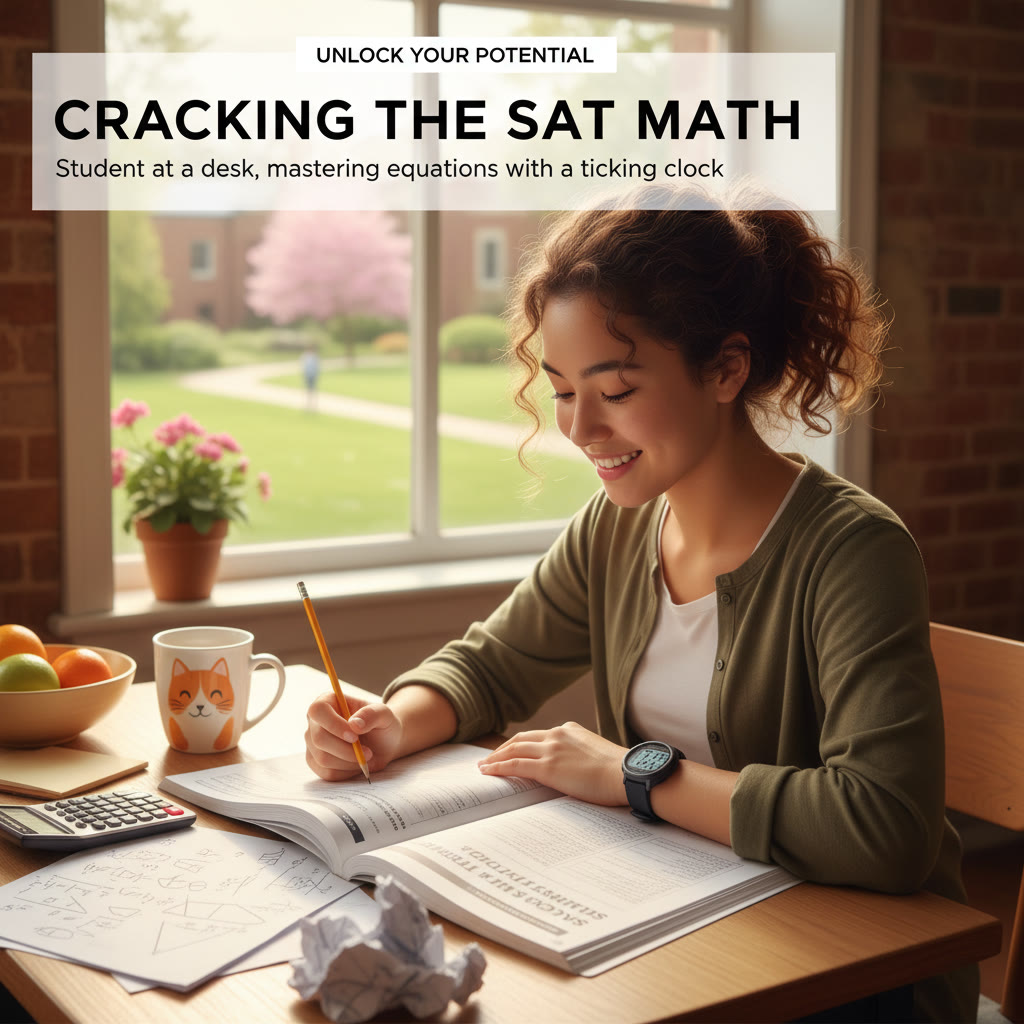Why accuracy and speed feel like opposing forces
If you ask most students what the SAT forces them to choose between, many will say patience and panic. Slow down and you may miss a handful of questions. Rush and you trade thinking through subtle traps for a frantic guess. The SAT is a test of both knowledge and pacing, and the truth is simple but often overlooked: speed without accuracy is noise, and accuracy without speed is wasted potential.
Think of the SAT like playing an instrument in an orchestra. Your knowledge is the sheet music, your accuracy is the notes you play correctly, and speed is the tempo. A clean performance at the wrong tempo still sounds off. The best SAT performers find the tempo where their instrument shines. That balance is what this post will help you find — with practical tactics, sample drills, and realistic planning. Along the way, I will occasionally point out how Sparkl s personalized tutoring and benefits, such as 1-on-1 guidance, tailored study plans, expert tutors, and AI-driven insights, can plug into this process if you want guided help.
Start with clear targets: score, percentile, and timeline
Before you tinker with timing drills and accuracy exercises, name the score you want, the time you have until test day, and the baseline accuracy you currently hit in practice. Goals give your practice a direction. For instance:
- Target score: 1400
- Current practice average: 1220
- Time to test: 8 weeks
With a goal and deadline, you can reverse-engineer the improvements you need in both speed and accuracy. If you need large jumps, early weeks should emphasize accuracy and concept mastery; as test day approaches, you shift toward timed practice and pacing. If you only need a small score bump, targeted speed work and strategy can be enough.
Understand how speed and accuracy affect score
On the SAT, every question counts roughly the same within a section, so one careless mistake cancels one well-thought-out correct answer. That means the highest marginal return often comes from preventing careless errors and avoiding mental blackouts under time pressure. Consider these rules of thumb:
- A 1-2% gain in accuracy on a full-length practice test usually yields a meaningful score increase.
- Improving speed by 10-15% without sacrificing accuracy can let you tackle harder questions that raise your score the most.
- Switching from random guessing to informed guessing after eliminating one or two choices increases expected score.
Quick example
Suppose you answer 52 of 58 questions correctly in a Math section. If you cut careless errors and convert 3 wrong answers into correct ones, you instantly jump up several scaled-score points. Alternatively, if you speed up enough to attempt 4 more questions and get half of them right, that also moves the dial. The decision of which path to pursue depends on why you missed questions in the first place.
Diagnose before you practice
Precision begins with honest diagnosis. Keep an error log that records the question, why you missed it, and what you will do next time. Typical categories include:
- Concept gap: you didn t understand a formula or grammar rule
- Careless error: arithmetic mistake, misreading, or misalignment of answer choices
- Timing pressure: you ran out of time and guessed
- Strategy failure: you picked a trap answer or had a poor guessing method
Once you can see patterns, allocate study time accordingly. Concept gaps need focused review, careless errors need deliberate practice to correct habits, and timing issues require pacing drills and strategic question triage.
Practical drills to improve accuracy
Accuracy is often easier to build than students assume. It requires slowing down, using reliable methods, and repeating those methods until they become automatic. Here are drills that help:
- Proofreading loop for Writing and Language: read each sentence three times with a different focus once for grammar, once for meaning, and once for concision.
- Step-check math problems: after you write a final answer, take 10 seconds to mentally reverse the steps or plug the answer back into the problem to catch arithmetic slips.
- Concept flashbacks: after solving a problem, write the underlying rule in one sentence. This reinforces conceptual memory.
- Deliberate error correction: recreate one incorrect problem and solve it again without looking, narrating your thought process aloud.
Micro-habits that prevent careless mistakes
- Underline or circle key numbers and what is being asked.
- Write units and keep columns aligned in math work.
- On reading passages, label paragraphs with quick one-word summaries in the margin.
Practical drills to improve speed
Speed follows practice that simulates pressure while protecting your accuracy. Speed drills are most effective when they are focused and short. Try these:
- 30-minute sprint: pick 20 SAT math problems you know well and solve them as quickly as possible without sacrificing accuracy. Track your time per problem.
- Section mini-tests: instead of always taking full practice tests, do timed 10- or 20-question blocks and immediately review errors.
- Question triage drill: practice quickly identifying whether a question is a 1-minute, 2-minute, or 4-minute problem and tag it accordingly.
- Mental math circuits: practice arithmetic and common manipulations until they are nearly automatic.
When to use the calculator
Saving seconds on arithmetic adds up, but over-reliance on a calculator can slow you if you waste time entering expressions. Decide before you begin which operations you will do by hand and which you will use the calculator for, and practice that split until it becomes habit.

Section-by-section timing guide
Understanding the structure of the SAT is key to allocating your time smartly. Below is a practical table with suggested time allocation and target accuracy ranges that work for many students. Use this as a starting point and tailor it based on your baseline performance.
| Section | Questions | Total Time | Avg Time per Question | Target Accuracy |
|---|---|---|---|---|
| Reading | 52 | 65 minutes | ~75 seconds | 80-90% |
| Writing and Language | 44 | 35 minutes | ~48 seconds | 85-95% |
| Math No Calculator | 20 | 25 minutes | ~75 seconds | 80-90% |
| Math Calculator | 38 | 55 minutes | ~86 seconds | 75-90% |
Notice how avg time per question varies. Reading and Math both require careful thought on some questions and faster recognition on others. The art is to move easily between speeds during the test.
Question triage: deciding what to do now and what to save
Question triage is the single most practical speed strategy. It is a three-step decision you make in 5-10 seconds per question:
- Can I see the path to a reliable answer in under 90 seconds? If yes, solve it now.
- If not, can I eliminate one or more answer choices to improve my guessing odds? If yes, make an informed guess and move on.
- If neither, mark the question and return after completing the rest of the section.
Use sticky marks in practice to simulate marking and returning. The key is not to beat yourself up for skipping; the best scorers pick their battles.
The role of practice tests and how to review them
Practice tests are where speed and accuracy converge, but raw volume alone is not enough. The real improvement happens in targeted review. After each practice test:
- Score the test and categorize each missed question in your error log.
- Note whether time was a factor: did you miss because you guessed or because you ran out of time?
- Create a micro-plan: 2-3 focused drills to correct the most frequent error types before the next test.
For example, if many reading mistakes come from misinterpreting detail questions, practice narrowing your highlights to who, what, when, and why. If math mistakes are often arithmetic slips, add daily 10-minute mental math warmups.
Psychology matters: managing stress on test day
Speed and accuracy aren’t just mechanical; they are psychological. Stress narrows attention and increases careless errors. Here are quick tactics to keep nerves from eroding your performance:
- Practice with simulated conditions, including timing and a warm-up routine. Familiarity reduces anxiety.
- Use a short breathing routine before each section to reset focus: inhale for four counts, exhale for four counts.
- Have a recovery ritual for rough patches: if a section starts poorly, take 30 seconds to re-center and then engage triage rigorously.
When to favor accuracy over speed — and vice versa
There is no one-size-fits-all rule, but here’s a useful guideline:
- Favor accuracy during the early preparation phase: build a solid foundation so that when you speed up, you don t amplify errors.
- Shift the emphasis to speed in the final 2-3 weeks: start practicing under strict timing and simulate test-day pacing.
- During a test, favor accuracy on the hardest questions that determine the top of your score band, and favor speed on easier, quick-win questions.
How tutors and personalized plans can accelerate the balance
One of the common bottlenecks in self-study is misdiagnosis and inefficient practice. A skilled tutor helps you identify the highest-leverage areas — the mistakes that are cheap to fix but deliver big score improvements. Sparkl s personalized tutoring can be especially valuable here: 1-on-1 guidance helps refine pacing habits, tailored study plans focus each week on your weakest threads, expert tutors model efficient thinking, and AI-driven insights can highlight question types where you waste the most time. That combination speeds up the trade-off between accuracy and speed.
Sample 8-week plan to balance accuracy and speed
Below is a flexible 8-week framework you can adapt based on your baseline and schedule. It balances intense accuracy work early with speed and mixed practice closer to test day.
- Weeks 1-2: Diagnosis and accuracy training. Build concepts, keep an error log, correct mistakes slowly and deliberately.
- Weeks 3-4: Introduce timed blocks. Start triage drills and short speed workouts while continuing concept review.
- Weeks 5-6: Increase timed practice volume. Take a full practice test every 7-10 days, review intensely, and work on test-day routines.
- Weeks 7-8: Peak phase. Full-length tests every 5-7 days, daily targeted speed drills, and final polishing of weak spots. Taper intensity in the last 48 hours before test day.
Real student story: finding a personal tempo
One student I worked with started with a tendency to over-annotate reading passages. She would spend too long highlighting and then rush the questions. After diagnosing the problem through timed mini-tests and an error log, we practiced three 15-minute reading sprints focused on main idea and paragraph labeling, and two error identification sessions where she explicitly cataloged why each wrong answer was chosen. Over six weeks she cut her average reading time per passage by nearly a minute while improving accuracy. The result wasn t faster guessing; it was a clearer, more efficient reading method that made comprehension automatic under time pressure.
Checklist: habits that improve both speed and accuracy
- Keep a persistent error log and review it weekly.
- Use timed mini-tests and triage practice at least three times a week.
- Practice smart guessing by eliminating choices rather than randomly guessing.
- Warm up before practice with short accuracy drills or mental math.
- Simulate test-day conditions frequently to build stamina and reduce anxiety.

Final thought: make pace a skill, not a panic
The balance between accuracy and speed is not some magical scale you either possess or lack. It s a skill you build with deliberate practice, honest diagnosis, and small changes that compound over time. Start with accuracy, teach yourself efficient habits, and then train speed in high-quality blocks. Use practice tests as experiments rather than punishments. If you find yourself stuck, targeted 1-on-1 guidance can make a huge difference: a skilled tutor helps you avoid wasted practice, design tailored study plans, and use tools like AI-driven insights to find the most impactful work. Sparkl s personalized tutoring can be an excellent fit for students who want that combination of human expertise and smart analytics.
Above all, remember that on test day you are not racing against the clock. You are managing your tempo to perform at your best. Find the pace where your thinking is clear, your accuracy is steady, and your choices are confident. With consistent work and a few smart strategies, you will get there.
Parting practical exercise
Today, try this 30-minute session: 10 minutes accuracy-only (untimed careful review of 5 problems), 10 minutes speed-only (20 easy problems as fast as you can while staying accurate), and 10 minutes review (note patterns and update your error log). Repeat weekly and watch the cross-pollination between speed and precision take effect.
Good luck, and treat pacing as your test-day companion, not your enemy. When you learn to dance with both speed and accuracy, the SAT starts to feel a lot more like a stage you can control.















No Comments
Leave a comment Cancel